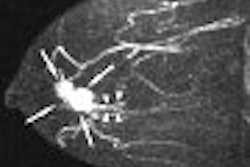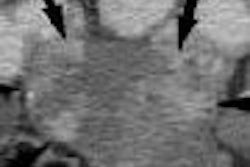BARCELONA - In the early stage of acute coronary syndrome, 16-slice multidetector-row CT can locate the culprit lesion, according to a presentation this week at the European Society of Cardiology's World Congress of Cardiology.
Researchers from University Hospital in Bordeaux, France compared 16-slice CT to 40-MHz catheter-based intravascular ultrasound (IVUS) in 20 consecutive patients who presented with acute coronary syndrome. Imaging studies were performed less than 48 hours after onset of symptoms.
Coronary plaque density was compared with echogenity assessed during three-vessel examination. Minimum lumen area and cross-sectional vessel area were manually traced for all significant lesions using multiplanar reconstructions that were oriented perpendicular to the longitudinal axis of the artery.
According to the results, 109 coronary segments were analyzed and 84 plaques were visualized by both techniques with good image quality. Multislice CT detected 19 of the 20 culprit lesions. Ten of those plaques were viewed in proximal segments of arteries on IVUS. Eight were hypoechogenic, five were hyperechogenic, and seven lesions were mixed.
Lead author Dr. Xavier Iriart said multislice CT proved effective in assessing lesions and their composition in carefully selected patients with stable coronary disease. However, plaque ruptures in five lesions, including ruptures in remote arteries in four patients, were not seen on CT, Iriart said.
Overall, measurements performed with multislice CT correlated well with IVUS (p < 0.001) although CT tended to overestimate vessel dimensions, he stated.
"While we can detect the lesion responsible for the symptoms, the clarity of the image is not yet ready for routine use in diagnosis," Iriart's group wrote in their electronic poster presentation. In comparison to IVUS, CT cannot ascertain the composition of the plaque as well as IVUS, especially for defining lesions that are likely to rupture, they explained.
Additionally, "the spatial resolution of the 16-slice CT remains a major drawback to quantitatively assess the severity of lesions in these unstable patients," the group stated.
By Edward SusmanAuntMinnie.com contributing writer
September 6, 2006
Related Reading
Dual-source imaging promises better CT scanning, June 15, 2006
Multidetector-row CT noninvasively measures coronary artery diameters, June 28, 2006
Copyright © 2006 AuntMinnie.com




















